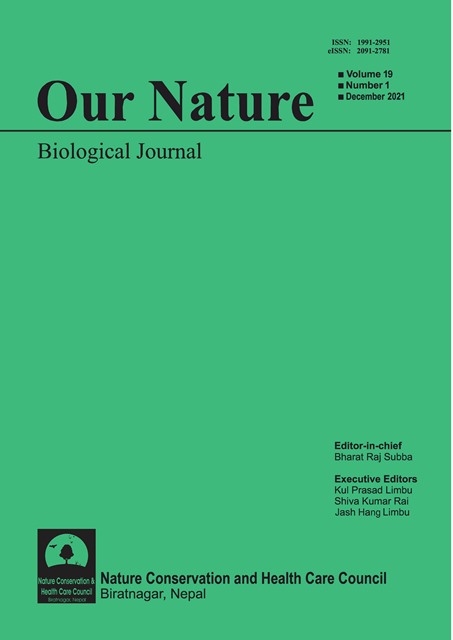An assessment of the Human-Elephant conflict in Sapahi and Kakadi Village of Kolhabi Municipality, Bara, Nepal
DOI:
https://doi.org/10.3126/on.v19i1.41223Keywords:
Conflict, crop damage, mitigation, perception, wild elephantAbstract
This study aims to assess the trend, extent, and impact of Human-Elephant conflict (HEC) in Sapahi and Kakadi villages of Bara district. Direct field observation, Household Survey (HHs), Focus Group Discussions (FGDs), and Key Informant Interview (KII) were carried out during November and December 2016 where 11 wards were selected purposively from two village and 50 households from each village. Also, 12 KII and one FGDs from each ward were performed. SPSS 20.0, and MS Excel 2016 were used to calculate mean, percentage, frequency count, and chi-square test was used to determine the variation in people’s perception towards wild Elephant conservation. The total average damage of paddy per year per HHs was 834.1 kg followed by wheat 153.7 kg, and mustard 2.12 kg. The economic value of average annual crop damage per year per HHs accounted for NRs. 22669.70. Among total HHs, 84% of the respondents said that the trend of crop damage is increasing, 10% found no differences in crop damage, and remaining 6% said decreasing. During the last 5 years, 7 people were injured, and 6 were killed. The lighting fire, beating drum, and making noise were the local techniques used by all the respondents to chase away elephant for the mitigation of HEC. The farmers also guard their fields at night time. 60% of the respondents are positive towards elephant conservation and remaining 40% seems no significance for conservation. The compensation scheme for crop damage should be properly implemented in the study area to minimize the HEC. A sustained conservation education program especially focusing on female, farmers, and nomads are recommended to conserve wild elephants, and their habitat.
Downloads
Downloads
Published
How to Cite
Issue
Section
License
Copyright (c) 2021 Akshay Chaudhary, Sachin Timilsina, Subash Gautam, Prajwol Babu Subedi

This work is licensed under a Creative Commons Attribution-NonCommercial 4.0 International License.
This license enables reusers to distribute, remix, adapt, and build upon the material in any medium or format for noncommercial purposes only, and only so long as attribution is given to the creator.




